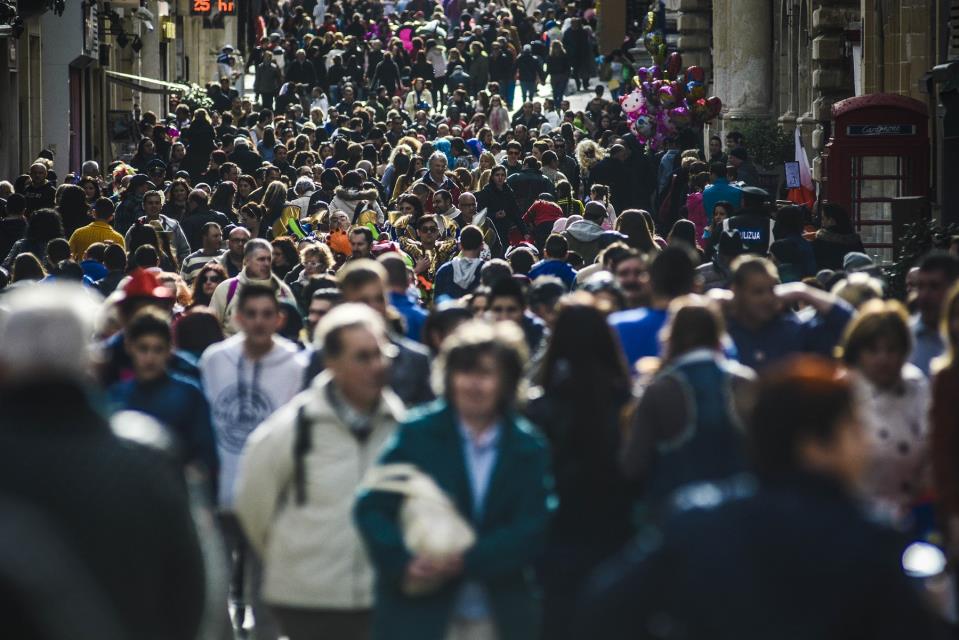The estimated total population of Malta and Gozo at the end of 2024 stood at 574,250, up by 1.9 per cent when compared to the previous year, the NSO said Thursday.
Males accounted for 53.1 per cent of the population. The population increase in 2024 was mainly dependent on the total net migration (immigration less emigration) of 10,614 persons. The net of non-EU citizens made up 76.6 per cent of the total net migrants in 2024.
Males accounted for 57.7 per cent of the total net migration. While net migration decreased by nearly half when compared to 2023 (49.4 per cent), emigration increased whereas immigration decreased in 2024.
Natural increase dropped by 55.3 per cent when compared to the previous year, from 432 in 2023 to 193 in 2024. This decrease was due to a decline in resident live births and an increase in resident deaths.
Resident live births in 2024 decreased by 2.0 per cent when compared to the previous year. Of the parents who gave birth in 2024, 38.5 per cent were aged 30 to 34 at the time of birth. Resident deaths in 2024 increased by 3.7 per cent over the previous year. Of the 4,181 resident deaths occurring during 2024, 71.1 per cent were persons aged 75 and over at the time of death.
As at end 2024, 53.1 per cent of the total resident population was male. An analysis of the population by age and sex reveals that the working-age groups (15-64 year olds) are predominantly male, whereas the population aged 65 and over is predominantly female. For persons aged 85 and above, females outnumbered males by a ratio of nearly two to one. Persons under the age of 18 made up 14.5 per cent of the total population, while 18.4 per cent were aged 65 and over. Of these, 3,773 persons – 2,645 females and 1,128 males – were aged 90 and over.
The total resident population, was made up of 70.6 per cent Maltese citizens and 29.4 per cent non-Maltese citizens. Regarding age structure, the distribution among Maltese nationals was relatively even across the main age groups: 13.5 per cent were aged 30-39, 14.3 per cent were aged 40-49, 12.1 per cent were aged 50-59, 13.5 per cent were aged 60-69, and 12.0 per cent were aged 70-79. In contrast, the non-Maltese population was more heavily concentrated in younger working-age cohorts, with 22.9 per cent aged 20-29, 34.3 per cent aged 30-39, and 18.3 per cent aged 40-49.
The overall population comprised 70.6 per cent Maltese citizens and 29.4 per cent foreign citizens. The Western district had the highest concentration of Maltese citizens at 86.5 per cent, followed by the Southern Harbour district (81.0 per cent) and South Eastern district (80.7 per cent). The Northern Harbour and Northern districts show higher shares of foreign citizens, at 42.3 per cent and 36.9 per cent respectively, with corresponding lower shares of Maltese citizens at 57.7 per cent and 63.1 per cent respectively.
The highest densities were recorded in central and harbour localities, notably Sliema (17,539 persons per km2), Pietà (15,691 persons per km2), and Isla (14,948 persons per km2). Other densely populated areas include Gżira (12,398 persons per km2), Fgura (12,239 persons per km2) and Tarxien (11,457 persons per km2), indicating a concentration of population in the inner harbour and surrounding zones.
In contrast, the localities of Għasri, San Lawrenz, and Mdina showed the lowest densities with 103, 223 and 227 persons per km2 respectively.
